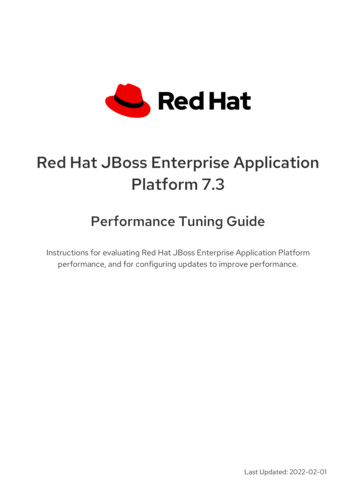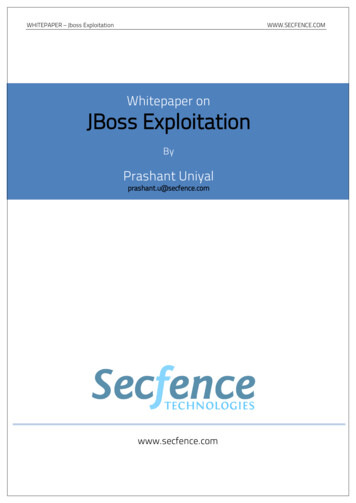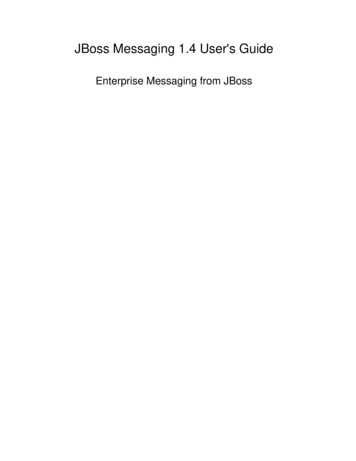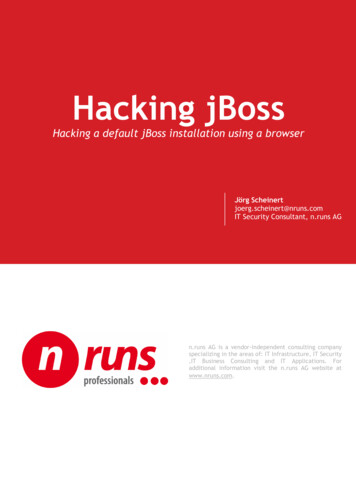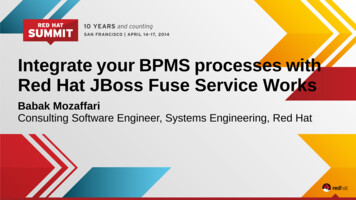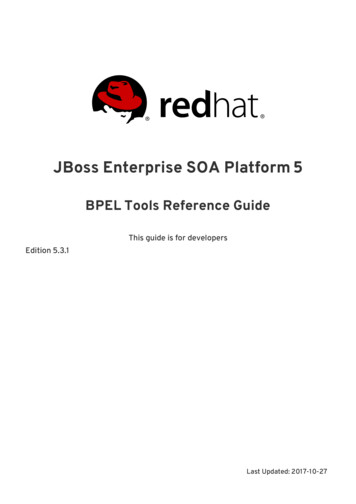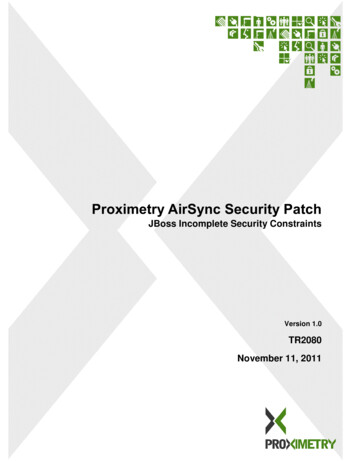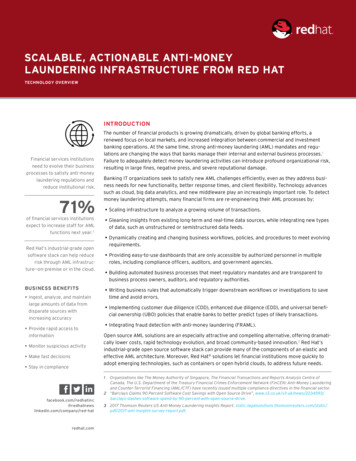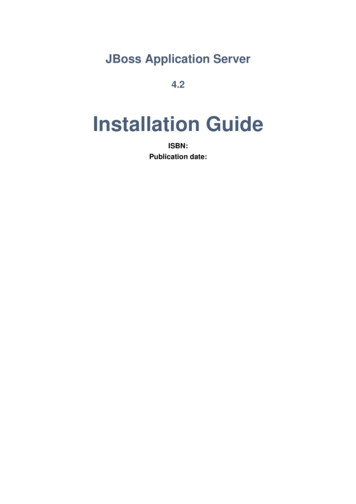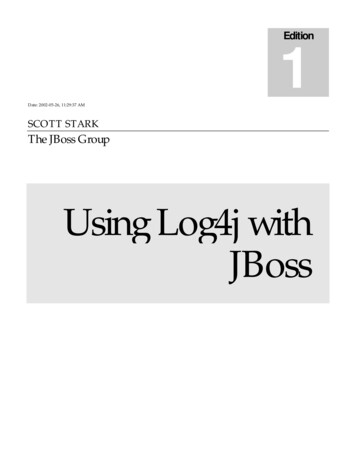
Transcription
1EditionDate: 2002-05-26, 11:29:37 AMSCOTT STARKThe JBoss GroupUsing Log4j withJBoss
P R E F A C E 0P A G ESCOTT STARK, AND THE JBOSS GROUPUsing Log4j with JBoss JBoss Group, LLC2520 Sharondale Dr.Atlanta, GA 30305 USAsales@jbossgroup.comPage 1 of 291
P R E F A C E 0P A G E2Table of ContentPREFACE. 2ABOUT THE AUTHORS . 2ACKNOWLEDGMENTS . 20.INTRODUCTION TO LOG4J . 3WHAT THIS BOOK COVERS . 31.AN OVERVIEW OF THE LOG4J API. 4The org.apache.log4j.Category class . 4org.apache.log4j.Logger . 6The JBoss org.jboss.log.Logger wrapper. 6The org.apache.log4j.Appender interface . 7The org.apache.log4j.Layout class . 8Configuring log4j using org.apache.log4j.PropertyConfigurator. 8Configuring log4j using org.apache.log4j.xml.DOMConfigurator . 10Log4j usage patterns. 18The Log4jService MBean . 19SUMMARY . 202.USING LOG4J . 21EMAIL NOTIFICATIONS BASED ON PRIORITY . 21The SMTPAppender . 21org.apache.log4j.AsyncAppender . 233.INDEX. 24Page 2 of 29
P R E F A C E 0P A G E3Table of ListingsListing 1-1, A summary of the key methods in the log4j Category class. 4Listing 1-2, A summary of the key methods in the log4j 1.2 Logger class. 6Listing 1-3, The JBoss Logger class summary. 6Listing 1-4,Tthe standard JBoss-2.4.x log4j.properties configuration file. 8Listing 1-5,Tthe standard JBoss-3.0.x log4j.xml configuration file. 14Listing 2-1, A SMTPAppender configuration sample 22Listing 2-2, An AsyncAppender configuration sample that delegates messages to the ErrorNotifications SMTPAppender 23Page 3 of 29
P R E F A C E 0P A G E4Table of FiguresFigure 1-1, The DTD for the configuration documents supported by the log4j version 1.1.3 DOMConfigurator. 12Figure 1-2, The DTD for the configuration documents supported by the log4j version 1.2.3 DOMConfigurator. 14Page 4 of 29
I N T R O D U C T I O NT OL O G 4 J— 0Page 1 of 29P A G E1
I N T R O D U C T I O NT OL O G 4 J— 0iPrefaceP A G E2PrefaceAbout the AuthorsScott Stark , Ph.D., was born in Washington State of the U.S. in 1964. He started out as achemical engineer and graduated with a B.S. from the University of Washington, and lattera PhD from the University of Delaware. While at Delaware it became apparent thatcomputers and programming were to be his passion and so he made the study of applyingmassively parallel computers to difficult chemical engineering problems the subject of hisPhD research. It has been all about distributed programming ever since. Scott currentlyserves as the Chief Technology Officer of the JBoss Group, LLC.JBoss Group LLC, headed by Marc Fleury, is composed of over 1000 developers worldwidewho are working to deliver a full range of J2EE tools, making JBoss the premier EnterpriseJava application server for the Java 2 Enterprise Edition platform.JBoss is an Open Source, standards-compliant, J2EE application server implemented in100% Pure Java. The JBossServer and complement of products are delivered under theLGPL license. With over 1,000,000 downloads, JBoss is the most downloaded J2EE basedserver in the industry.AcknowledgmentsThanks go out to the Log4j developers for establishing and maintaining such a flexiblelogging framework.Page 2 of 29
I N T R O D U C T I O NT OL O G 4 J— 00ChapterP A G E30. Introduction to Log4jWhat is Log4j and why do we use itLogging of messages is a common requirement in all applications. In a server environment itis a critical feature due to the distributed multi-user interaction that is characteristic of aserver. Many users interact simultaneously with an application server and some degree oflogging of the interactions is essential for support. A unique aspect of an application server isthat many different developers may have contributed code to the applications that comprisethe active components. The logging requirement could vary significantly between thevarious components or applications. What is needed is a flexible logging API that supportsthese use cases. The JBoss server has standardized on log4j as its logging API. The switch tolog4j has been a gradual one, and as of the 2.4.4 release, log4j is the only logging API usedinternally by JBoss. JBoss-2.4.6 includes the log4j 1.1.3 release while JBoss-3.0.0 includesthe log4j 1.2.3 release. The JBoss-2.4.6 version can be used with the log4j 1.2 release bysimply replacing the log4j.jar in the JBoss distribution with the 1.2 version of the log4j.jar.Although there are many logging APIs, including the JSR47 logging framework that isbundled with the current JDK 1.4 release, the log4j API appears to the most commonly usedof all available. It is designed to be fast, flexible, and simple. Further, the log4j community isvery active and responsive to both bug reports and feature requests. These are probably themost important criteria for an application server logging framework.What this Book CoversThe focus of this book is using Log4j within JBoss. After an overview the Log4j API we gointo the details of configuring and using Log4j. Both the log4j 1.1.3 log4j 1.2.3 releases arediscussed as JBoss 2.4.x uses log4j 1.1.3 while JBoss 3.x uses log4j 1.2.3.Page 3 of 29
A NO V E R V I E WO FT H EL O G 4 J1ChapterA P I1. An Overview of the Log4j APIWhat is the Log4j API and how does it fit into JBoss.Log4j has four fundamental objects: categories, priorities, appenders and layouts. Of these,API users directly use only categories and maybe priorities. Together these componentsallow developers to log messages according to message type and priority, and to control atruntime how these messages are formatted and where they are reported. We will cover thebasics of log4j to allow you to understand the JBoss log4j configuration and help get youstarted using log4j in your components. For additional documentation refer to the log4jhome page, which is located here: http://jakarta.apache.org/log4j/.The org.apache.log4j.Category classThe central component in the log4j 1.1.3 API is the org.apache.logj4.Category class. Acategory is a named entity and its name is a case-sensitive, hierarchical construct whosenaming hierarchy adheres to the following rule, which is taken from the log4j manual:A category is said to be an ancestor of another category if its name followed by a dot is a prefix ofthe descendant category name. A category is said to be a parent of a child category if there are noancestors between itself and the descendant category.This is the same convention as the Java package namespace. There exists a special rootcategory that simply is, but has no name. It is accessed via a static method of the Categoryclass. The Category class itself contains a large number of methods, but only the factory,logging and priority state methods are of general interest. A summary of the Category classrestricted to these methods is summarized in Listing 1-1.Listing 1-1, A summary of the key methods in the log4j Category class.public class Category{public static Category getRoot()public static Category getInstance(Class clazz)public static Category getInstance(String name)Page 4 of 29
A NO V E R V I E cpublic}O FT H EL O G 4 JA P Ivoid debug(Object msg)void debug(Object msg, Throwable t)boolean isDebugEnabled()void info(Object msg)void info(Object msg, Throwable t)boolean isInfoEnabled()boolean isEnabledFor(Priority priority)void log(Priority priority, Object msg)void log(Priority priority, Object msg, Throwable t)Before going through the methods we need to define the Priority class that shows up in theCategory method signatures. The org.apache.log4j.Priority object represents the importanceor level of a message. Whenever you log a message it has a Priority associated with it. Thereare a small number of Priorities defined by default and are know by the names: FATAL,ERROR, WARN, INFO and DEBUG. You can extend the set of known priorities byproviding subclasses of the Priority class. The utility of assigning a priority to a message isthat it allows one to filter messages based on their priority or importance. Further, you cantest to see if a given priority has been enabled for a Category to avoid generating logmessages that would have no affect due to the current priority filters. This is important forhigh frequency debugging messages whose volume can adversely impact the server. Priorityobjects have both a string name and an integer value. The name is simply a mnemonic labelfor the priority. The integer value defines a relative order amongst priorities. This allows oneto enable or disable all priorities below a given threshold.Log4j 1.2 note, the org.apache.log4j.Priority class has been superceded by theorg.apache.log4j.Level class to make the log4j API consistent with the java.util.logging package ofJDK 1.4 . The Level class extends Priority and is the preferred construct for representingmessage importance.The getRoot method is an accessor for the anonymous root of the default category hierarchy.The getInstance method is a factory method which returns the unique Category instanceassociated with the given name. If the category does not exist it will be created. The versionthat accepts a Class simply calls getInstance(clazz.getName()).The debug, isDebugEnabled, info, and isInfoEnabled methods are convenience methods thatinvoke the corresponding log or isEnabledFor method with the Priority that corresponds thepriority associated with the convenience method. For example, debug(Object) simply invokeslog(Priority.DEBUG, Object).The isEnabledFor(Priority) method checks to see if the Category will accept a message of theindicated Priority. The log(Priority, Object) and log(Priority, Object, Throwable) pass thePage 5 of 29
A NO V E R V I E WO FT H EL O G 4 JA P Imessage onto the appenders associated with the Category provided that the messages passthe current Priority filter.org.apache.log4j.LoggerIn log4j 1.2, the Category class has been superceded by the org.apache.log4j.Logger class tobe more consistent with the JDK 1.4 java.util.logging package. The Logger class is anextension of Category that only adds factory methods for obtaining anorg.apache.log4jLogger instance. The key methods of the Logger class are shown in Listing1-2.Listing 1-2, A summary of the key methods in the log4j 1.2 Logger class.public class Logger extends Category{public static Logger getLogger(Class clazz)public static Logger getLogger(Class clazz)public static Logger getRootLogger()}The Category class has been deprecated in log4j 1.2 and its javadoc warns:This class has been deprecated and replaced by the Logger subclass. It will be kept around topreserve backward compatibility until mid 2003.The JBoss org.jboss.log.Logger wrapperThe JBoss server framework actually uses a simple wrapper around the log4j Category. Thiswrapper adds support for a custom TRACE level priority and removes the unused Categorymethods. This does not interfere with the log4j Category usage in any way. The Logger classsimply provides a collection of explicit log priority convenience methods as well as a factorymethod as show in Listing 1-3.Listing 1-3, The JBoss Logger class summary.package org.jboss.logging;import org.apache.log4j.Category;import org.apache.log4j.Priority;public class Logger{private Category log;public static Logger getLogger(String name)Page 6 of 29
A NO V E R V I E WO FT H EL O G 4 JA P Ipublic static Logger getLogger(Class clazz)public Category getCategory()public boolean isTraceEnabled()public void trace(Object message)public void trace(Object message, Throwable t)public boolean isDebugEnabled()public void debug(Object message)public void debug(Object message, Throwable t)public boolean isInfoEnabled()public void info(Object message)public void info(Object message, Throwable t)public void warn(Object message)public void warn(Object message, Throwable t)public void error(Object message)public void error(Object message, Throwable t)public void fatal(Object message)public void fatal(Object message, Throwable t)public void log(Priority p, Object message)public void log(Priority p, Object message, Throwable t)}Not only does this provide direct support for the TRACE level priority used internally by theJBoss server for high-frequency messages that should not normally be displayed, it alsoavoids the problem of introducing a custom Category factory. In previous versions of JBoss,support for the TRACE priority was done using a custom subclass of Category that addedthe trace support methods. The problem with the custom subclass is that it tended to resultin integration problems like ClassCastException errors with custom user services.You are free to use the JBoss Logger class if you want to take advantage of the TRACE levelpriority feature. If you are writing custom MBeans or other services that extend from JBossclasses it is likely that you inherit a Logger instance for use. If you are writing applicationsthat should remain independent of the JBoss classes, then use of the JBoss Logger classshould be avoided in place of the standard org.apache.log4j.Category ororg.apache.log4j.Logger.The org.apache.log4j.Appender interfaceThe ability to selectively enable or disable logging requests based on their category is only arequest to log a message. The appenders associated with the category that receives the logmessage handle the actual rendering of the log message. An appender is a logical messagePage 7 of 29
A NO V E R V I E WO FT H EL O G 4 JA P Idestination. An appender delegates the task of rendering log messages into strings to thelayout instance assigned to the appender. There can be multiple appenders attached to acategory, which means that a given message can be sent to multiple destinations. Allappenders must implement the org.apache.log4j.Appender interface. This interface imposesthe notions of layouts as well as filters and error handlers. A number of appenders arebundled with the log4j framework, including appenders for consoles, files, GUI components,remote socket servers, JMS, Windows event loggers, and remote UNIX syslog daemons.Appenders also exist which allow the rendering of messages to occur asynchronously.The org.apache.log4j.Layout classThe rendering of a log message into a string representation is delegated to instances of theorg.apache.log4j.Layout class. A Layout is a formatter that transforms anorg.apache.log4j.spi.LoggingEvent object into a string representation. A Layout can alsospecify the content type of the string as well as header and footer strings.Configuring log4j using org.apache.log4j.PropertyConfiguratorThat is really all you need to know to use the log4j API to perform logging from components.One large detail missing so far is how to configure log4j. This entails setting the categorypriorities as well as configuration of the appenders associated with categories. The log4jframework provides support for programmatic configuration as well as configuration usingXML and Java properties files. We'll discuss the Java properties file configuration method asthis is what JBoss uses in its standard configuration.The Java properties file based configuration of log4j is handled by theorg.apache.log4j.PropertyConfigurator class. The PropertyConfigurator class reads theconfiguration information for category priority thresholds, appender definitions, andcategory to appender mappings from a Java properties file. The properties file can bechanged at runtime to modify the active log4j configuration. We'll learn the basic syntax ofthe PropertyConfigurator properties file by discussing the standard JBoss log4j.propertiesfile given in Listing 1-4.Listing 1-4,Tthe standard JBoss-2.4.x log4j.properties configuration file.# A default log4j properties file suitable for JBoss### Appender Settings ###### The server.log file appenderlog4j.appender.Default t.File ./log/server.loglog4j.appender.Default.layout org.apache.log4j.PatternLayout# Use the default JBoss ern [%c{1}] %m%n# Truncate if it aleady exists.Page 8 of 29
A NO V E R V I E WO FT H EL O G 4 JA P Ilog4j.appender.Default.Append false### The console appenderlog4j.appender.Console der.Console.Threshold INFOlog4j.appender.Console.layout le.layout.ConversionPattern [%c{1}] %m%n### Category Settings ###log4j.rootCategory DEBUG, Default, Console# Example of only showing INFO msgs for any categories under# org.jboss.util#log4j.category.org.jboss.util INFO# An example of enabling the custom TRACE level priority that is# used by the JBoss internals to diagnose low level details. This# example turns on TRACE level msgs for the org.jboss.ejb.plugins# package and its subpackages. This will produce A LOT of logging# output.#log4j.category.org.jboss.ejb.plugins TRACE#org.jboss.logging.TracePriorityThe first thing to note is that property names in the file are compound names whosecomponents are separated by periods. This is a common pattern used in property files togroup properties together. There are really only two classes of properties being defined inListing 1-4, appenders (prefix log4j.appender) and categories (prefix log4j.category,log4j.rootCategory is a special case for the default root category).The first section of the file (### Appender Settings ###) defines the log4j appenderconfiguration. Property names that begin with the "log4j.appender" prefix specify propertiesthat apply to Appender instances. The first component in the property name after thelog4j.appender prefix is the name of the appender. Thus, the first appender configuration isfor the appender named "Default". The log4j.appender.Default property defines the type ofappender implementation to use. In this case, the org.apache.log4j.FileAppender is specified.The FileAppender implementation represents a file destination. All properties with thelog4j.appender.Default prefix define properties on the Default appender instance. The set ofproperties one can specify for a given appender depend on the appender type. For theFileAppender the name of the log file, the Layout instance to use, and whether existing logfiles should be appended to are allowed properties. Thelog4j.appender.Default.layout.ConversionPattern property is setting the ConversionPatternproperty value for the log4j.appender.Default.layout property of the FileAppender. The typeof the Layout instance was specified to be org.apache.log4j.PatternLayout by thelog4j.appender.Default.layout property. Refer to the log4j javadocs for the complete syntax ofthe format string the PatternLayout class supports.The log4j.appender.Console properties configure a second appender named Console. Thisappender sends its output to the System.out and System.error streams of the console inPage 9 of 29
A NO V E R V I E WO FT H EL O G 4 JA P Iwhich JBoss is run. One feature common to most appenders, and illustrated by the Consoleappender configuration, is the ability to filter out log events whose priority is below somethreshold. The log4j.appender.Console.Threshold INFO setting says that only events withpriorities greater than or equal to INFO should be handled by an appender. All othermessages should simply be ignored.The second section of the file (###Category Settings ###) defines the appender to categorymappings as well as the category priority thresholds. The root category specification ofthreshold priority and associated appenders is a special case of the log4j.category grouping ofproperties, which has the following syntax:log4j.rootCategory [priority] [(, appenderName)*]So, the log4j.rootCategory entry in Listing 11.4 states that the root category prioritythreshold is set to DEBUG, and its appenders are Default and Console. The general syntaxfor the category setting is:log4j.category.category name [priority] [(, appenderName)*]There are two commented out examples of the general form. The first states that theorg.jboss.util category and its subcategories should filter all messages below the INFOpriority level. The second, states that the org.jboss.ejb.plugins category should filter allmessages below the custom TRACE#org.jboss.logging.TracePriority priority level. Sincelog4j does not know which class provides the custom priority implementation, the class mustbe specified using the "#classname" suffix added to the name of the priority.Configuring log4j using org.apache.log4j.xml.DOMConfiguratorThe XML based org.apache.log4j.xml.DOMConfigurator configuration class offers moreflexibility and the benefits, and drawbacks, of an XML based configuration. As we'll describein the Log4jService MBean configuration section, JBoss supports both the properties file andXML version of the log4j configuration files. For reference, the DTD for the configurationdocuments supported by the DOMConfigurator of Log4j version 1.1.3 is given in Figure 1-1,and the DTD for Log4j version 1.2.3 is given in Figure 1-2.Page 10 of 29
A NO V E R V I E WO FT H EL O G 4 JA P IPage 11 of 29
A NO V E R V I E WO FT H EL O G 4 JA P IFigure 1-1, The DTD for the configuration documents supported by the log4j version 1.1.3DOMConfigurator.Page 12 of 29
A NO V E R V I E WO FT H EL O G 4 JA P IPage 13 of 29
A NO V E R V I E WO FT H EL O G 4 JA P IFigure 1-2, The DTD for the configuration documents supported by the log4j version 1.2.3DOMConfigurator.We'll learn the basic syntax of the DOMConfigurator properties file by discussing thestandard JBoss log4j.xml file given in Listing 1-4.Listing 1-5,Tthe standard JBoss-3.0.x log4j.xml configuration file. ?xml version "1.0" encoding "UTF-8"? !DOCTYPE log4j:configuration SYSTEM "log4j.dtd" !- For more configuration infromation and examples see the Jakarta Log4j owebsite: http://jakarta.apache.org/log4j-- log4j:configuration xmlns:log4j "http://jakarta.apache.org/log4j/" debug "false" !-- -- !-- Preserve messages in a local file -- !-- -- !-- A time/date based rolling appender -- appender name "FILE" class er" param name "File" value " {jboss.server.home.dir}/log/server.log"/ param name "Append" value "false"/ !-- Rollover at midnight each day -- param name "DatePattern" value "'.'yyyy-MM-dd"/ !-- Rollover at the top of each hour param name "DatePattern" value "'.'yyyy-MM-dd-HH"/ -- layout class "org.apache.log4j.PatternLayout" !-- The default pattern: Date Priority [Category] Message\n -- param name "ConversionPattern" value "%d %-5p [%c] %m%n"/ !-- The full pattern: Date MS Priority [Category] (Thread:NDC) Message\n param name "ConversionPattern" value "%d %-5r %-5p [%c] (%t:%x) %m%n"/ -- /layout /appender !-- A size based file rolling appender appender name "FILE" class "org.jboss.logging.appender.RollingFileAppender" param name "File" value " {jboss.server.home.dir}/log/server.log"/ param name "Append" value "false"/ param name "MaxFileSize" value "500KB"/ param name "MaxBackupIndex" value "1"/ layout class "org.apache.log4j.PatternLayout" param name "ConversionPattern" value "%d %-5p [%c] %m%n"/ /layout /appender Page 14 of 29
A NO V E R V I E WO FT H EL O G 4 JA P I-- !-- -- !-- Append messages to the console -- !-- -- appender name "CONSOLE" class "org.apache.log4j.ConsoleAppender" param name "Threshold" value "INFO"/ param name "Target" value "System.out"/ layout class "org.apache.log4j.PatternLayout" !-- The default pattern: Date Priority [Category] Message\n -- param name "ConversionPattern" value "%d{ABSOLUTE} %-5p [%c{1}] %m%n"/ /layout /appender !-- -- !-- More Appender examples -- !-- -- !-- Buffer events and log them asynchronously appender name "ASYNC" class "org.apache.log4j.AsyncAppender" appender-ref ref "FILE"/ appender-ref ref "CONSOLE"/ appender-ref ref "SMTP"/ /appender -- !-- EMail events to an administrator appender name "SMTP" class "org.apache.log4j.net.SMTPAppender" param name "Threshold" value "ERROR"/ param name "To" value "admin@myhost.domain.com"/ param name "From" value "nobody@myhost.domain.com"/ param name "Subject" value "JBoss Sever Errors"/ param name "SMTPHost" value "localhost"/ param name "BufferSize" value "10"/ layout class "org.apache.log4j.PatternLayout" param name "ConversionPattern" value "[%d{ABSOLUTE},%c{1}] %m%n"/ /layout /appender -- !-- Syslog events appender name "SYSLOG" class "org.apache.log4j.net.SyslogAppender" param name "Facility" value "LOCAL7"/ param name "FacilityPrinting" value "true"/ param name "SyslogHost" value "localhost"/ /appender -- !-- Log events to JMS (requires a topic to be created) appender name "JMS" class "org.apache.log4j.net.JMSAppender" param name "Threshold" value "ERROR"/ param name "TopicConnectionFactoryBindingName" value "java:/ConnectionFactory"/ Page 15 of 29
A NO V E R V I E WO FT H EL O G 4 JA P I param name "TopicBindingName" value "topic/MyErrorsTopic"/ /appender -- !-- -- !-- Limit categories -- !-- -- !-- Limit JBoss categories to INFO category name "org.jboss" priority value "INFO"/ /category -- !-- Increase the priority threshold for the DefaultDS category category name "DefaultDS" priority value "FATAL"/ /category -- !-- Decrease the priority threshold for the org.jboss.varia category category name "org.jboss.varia" priority value "DEBUG"/ /category -- !- An example of enabling the custom TRACE level priorit
With over 1,000,000 downloads, JBoss is the most downloaded J2EE based . log4j has been a gradual one, and as of the 2.4.4 release, log4j is the only logging API used internally by JBoss. JBoss-2.4.6 includes the log4j 1.1.3 release while JBoss-3.0.0 includes
